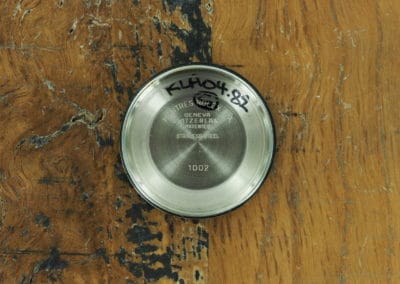An Introduction to Watch Restoration
This is probably the part of my profession I love the most. Restoration is a taboo in the watch world, and definitely the most controversial, misunderstood and abused theme above all. Personally - and that is no secret - I advocate sensitive, conservative restoration as probably the key factor to grant a future to watch collecting and protect all watch investments, past and future. The great truths and secrets behind this extraordinarily sophisticated practice are often object of the commentary on my the "My Take" page, my personal blog. I strongly advise that you make of yourself an informed person regarding watch restoration. Making yourself capable of evaluating, assessing and truly understanding the facts regarding watch restoration will make you a wiser and smarter buyer, investor and collector: exactly like the many major international dealers I have been assisting in these last years are doing. Be prepared to be in awe before the extraordinary results of restoration projects coordinated and supervised by myself with he avail of some of the most talented watchmakers, goldsmiths, dial factories and artisans worldwide.I have to admit that, as much as I dreamt of a future in which the whole world would be into vintage watches, I am still incredulous at seeing what is actually happening.
It was just a few years ago that big collectors were only a handful and the majority of watch collectors aimed mainly at having one example of their favorite brand or model: one Daytona, one Submariner – or GMT, or Explorer – one gold watch – a Day-Date, a Datejust – a Patek Philippe, a Breguet (which wasn’t really a vintage watch, but everyone felt it was a must to have one in a real watch collection).
A vintage steel – gold for the most sophisticated – Jaeger-LeCoultre Reverso and a Rolex bubble back were other watches just about every real vintage collector needed to have.
Watches were generally meant to be kept forever, although every now and then something would be sold to upgrade in favor of a more important piece. Rectangular watches were big, and any Patek Philippe bearing the rectangular (ok, octagonal) caliber 9-90 was regarded to as a V12 Ferrari even in the least exciting case and dial design configuration.
We had no clue of how many examples of any particular watch existed out there, and the limited number of watch aficionados compared to large number of watches that were coming back to the market every day, gave us the false impression that anything could be sold and replaced without a problem at any future time and more or less for the same money, as that’s exactly what would normally happen.
From the number of Patek Philippe 1518 you saw popping up on auction catalogs in those days, you had to believe they must have made at least a couple of thousand.
In a general line of thinking, the more “antique” the watch the more valuable it would prove on the market when it came to real collectibles. In the mid-late ‘80s timepieces from the ‘60s and ‘70s were seen more as discontinued but still cool watches to wear, more often than not at a much lower price than their new versions.
We were learning about productions’ history gradually, and although sticking to the original specs of a given watch was always a good idea, many end users would not refrain from having their watches “adjusted” to best suit their taste: black bezels would go on Rolex 6265s, big red dials on 6239s, solid link bracelets replaced original riveted ones, black – refinished – dials took the place of silvered original ones, and so on. Let’s face it: we didn’t know the first thing about watches compared to what you need to know today to be a collector or a professional.
And yet, I don’t think there has ever been a better time to learn about them then those years. Whereas the educational aspect of the watch collecting experience was incredibly much poorer than today, another one had a more prominent weight: we would actually buy watches that we liked, with the plain purpose of wearing them.
It may sound obvious, but with today’s “forensic” approach to assess the altogether – not only financial – value of vintage watches, people have lost the ability, or the interest, to consider their looks.
At today’s prices the modern collector needs to feel protected from making a mistake, and his need for certain, unquestionable criteria has changed the way we look at watches: to most – but fortunately not all – there seem to be no way to tell if a watch has the “magic” or not without exposing it to a UV light, inspect it with a microscope, gauge it with a Geiger tester and check its life long auction history, God forbid someone had replaced a dial or a set of hands some twenty years ago, albeit with a better one.
But the fact is that anyone with basic reading and writing skills – whether they can tell their right shoe from the left or not – can perform these tests and proclaim himself a professional vintage watch expert and consultant: hence, a new business – that requires no investment other than that of their clients and of the watch dealers – is flourishing, and a new, philatelic way to appreciate watches is replacing the old, primitive one.
I expect that in a very next future they will be able to select Miss Universe – as well as any other beauty contest pageant -only by her body measurements, dental x-rays and blood works.
Personally, I’ll still stick to the old school way to find every woman’s beauty and mystery in nuances that cannot be measured.





